Note: Kino has Canceled this release! September 25, 2014.
The few review discs out there will now be collector's items, like the old Dark Sky disc of Kill, Baby, Kill! that suffered the same fate.
Reviewed by Glenn Erickson
Why get the trimmed American Black Sabbath? It's Karloff, man, speaking in his own voice. And on Black Sunday, a better music track...
It's been almost 25 years since Tim Lucas's magazine Video Watchdog began, bringing fantastic film fans the hidden stories behind the original European versions of our favorite Italian horror films. This reviewer saw Caltiki, the Immortal Monster on the big screen as a child and had no idea where it came from. Even as an adult I assumed it had been a Mexican production. Unless one had access to trade journals or exotic foreign magazines, the world of Euro-horror was an intriguing blank.
Then came home video. Mario Bava soon became a hot subject for Video Watchdog, and it wasn't long before we got the full stories behind his sensational horror pictures. American-International Pictures imported the genuinely scary La maschera del demonio and made Barbara Steele an immediate cult star; only later did we find out to what degree censorship alterations had been performed on our U.S. version. Bava's I tre volta della paura underwent even more changes for its American release.
These pictures were two of the first horror film surprises of the DVD surge of the late 1990s, when Image released them in their original European versions. Fans that had seen them faded, battered and severely edited on TV could now appreciate Bava's visual artistry. Blu-rays followed just two years ago, from Kino Classics.
But fans felt cheated when foreign-region BDs of these titles showed up that also included American-International's altered cuts, the versions we knew and remembered from scary matinees and TV broadcasts. When A.I.P. lost the rights, they disappeared completely. An early laserdisc combo of the two titles remained the only decent way to see them.
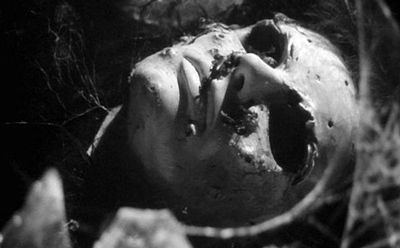
Now Kino has released a double bill of the American cuts, titled Black Sunday and Black Sabbath. Since I've already reviewed the previous Italian versions, I'll ask readers new to the subject (more are being born every year) to refer to those articles for my take on what makes them so great:
Italian Export Version of Black Sunday;
Italian Version of Black Sabbath
What's different about the versions? I checked out the old and new of each to see if Everything I Wanted to Know About Bava But Was Afraid to Ask was true. And whattaya know, Sir Lucas of Cincinnatti told the truth. Here's what I learned.
A.I.P's domestic version of Black Sunday is about three minutes shorter than the Italian original. Most every scene of gory violence is trimmed. This includes the witch Asa's branding and the shot of the mask hammered to her head. A brief cut of an eye piercing is missing. If other gruesome images have been shortened, I didn't get that detailed. Dr. Kruvajan's open-mouthed kiss of the reclining, puncture-face Asa was shortened, dropping a shot of the actual kiss. Older prints leave a black slug where this shot used to be; A.I.P. apparently found it easier to leave the screen blank rather than re-jigger the soundtrack. This perhaps indicates that the Production Code Office's instructions to remove the shot came after the shortened version had been re-mixed. This new disc closes the gap, shortening the film by three seconds or so.
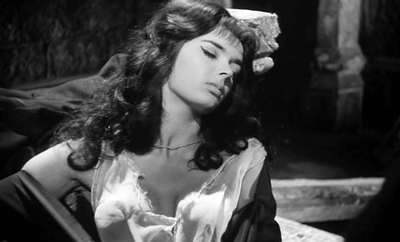
A.I.P completely redid the soundtrack. Purists will go for the original Italian audio, which has yet to appear on any U.S. release. The new dialogue track by Titra has more energy, even if a couple of its dubbing artists have those generic-sounding voices we remember from a million and one sword 'n' sandal films. The big switch, and the A.I.P. alteration most missed by fans, is Les Baxter's replacement score. Roberto Nicolosi's original is dull, surprisingly. The film has more tension when Bava leaves the screen silent save for sound effects, as when the spiked mask is revealed to the audience. Baxter's track is bigger, more active, and has strong themes for episodes of menace and romance. It plays extremely well in transitions between the castle and Asa Vajda's eerie crypt. The slow-motion ghost coach is given a very effective cue. This is one of Les Baxter's best scores for A.I.P.
The brightly colored Black Sabbath originally had more adult content, and accordingly underwent even more editorial changes. The episode called "The Telephone" was completely reworked to excise a lesbian theme, the story of which I remember making fascinating reading in VW. When we saw the Italian original we were excited by the widescreen color images and its different set of Boris Karloff host segments. In Italy Karloff appeared only at the beginning and the end. His final appearance was a back-stage joke, in character as the vampire Gorca from the "Wurdulak" episode.
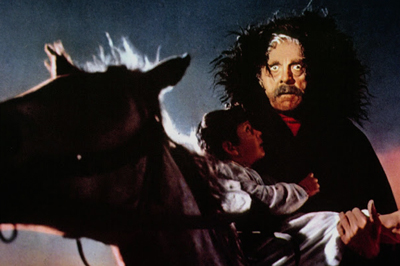
Boris Karloff is the main reason fans have been impatient to see the American version revived: he speaks in English, in his own voice. He apparently performed as Gorca in English as well; and this dub with his irreplaceable, infinitely superior vocal performance kicks Black Sabbath several notches upward in appeal. Karloff's host segments are more varied in the American version, which adds to the fun. The higher-pitched dubbed voice used for the Italo version had no special qualities.
Les Baxter's music for this show is a mixed bag. Roberto Nicolosi's original cues are lively when they need to be, and stayed out of the way when a basic, non-amplified suspense feeling was indicated. Baxter's music works almost as well, but is not as big an improvement. It's also a little irritating when the U.S. version slips into an unfunny comic mode at the finish, going goofy with a snippet of a John Phillips Sousa march, etc. The cue title on Baxter's original music cue sheet is "Movie Set", which we interpret as referencing the Italian joke ending. Baxter must have seen a cut with the gag ending intact and written a corresponding "wacky" cue. After AIP dropped the Karloff-on-a-hobby horse finish Baxter's music no longer made any sense.
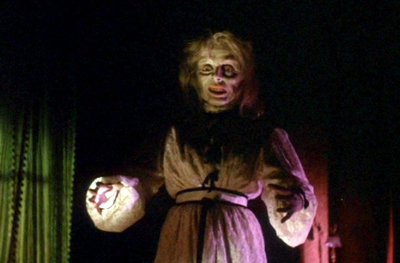
Overly obsessed film fans (who, me?) that dabble with editing software sometimes make their own versions of movies -- just the way a few annoying rights holders like to inflict their personal revisions on the films they control. Kino and International Media Films stick to the original versions here, which is a good thing. But we immediately fantasize a Black Sunday variant using the long version, but with American dialogue and the Les Baxter score. And wouldn't it be nice to have Black Sabbath the way we really want to see it, All original Italian except for Karloff's voice where possible? Surely we wouldn't mind if the Polish Wurdulak answered in English, when his Polish family spoke in Italian -- that sounds fine to me. 1
The Kino Classics Blu-ray of the U.S. Release Versions of Black Sunday & Black Sabbath were taken from A.I.P.'s original printing elements, which are a number of film generations away from the source used for the European versions. Therefore they don't look quite as good. Black Sunday is acceptable yet has less detail and more grain; it also has less contrast and definition. One does have to see them side-by-side to tell. Black Sabbath is much the same story, with a softer and slightly less pleasing image than the more colorful, lush-looking Blu-ray of the Italian cut.
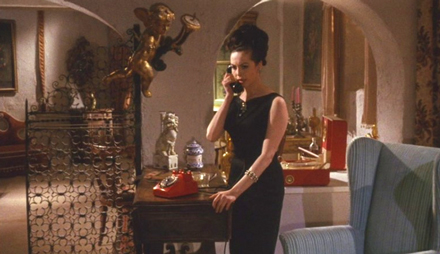
On Black Sabbath starting at the beginning of Karloff's intro for "The Wurdulak" the audio sync slips. Karloff's voice is a little early, just enough to throw it off. The audio remains out of synch throughout the episode. For the record, my screener is a final product disc and I checked this on two separate Blu-ray players.
That's the trade-off. These U.S. cuts are very watchable, and there are plenty of fans out there that will want to see for themselves how A.I.P.'s editors bowdlerized the "Telephone" and still came up with a moderately scary episode. And who doesn't want to see and hear Boris Karloff?

The lone extra on these shows is a set of trailers for other Bava pictures, seen before on other discs. Black Sunday is a really rough dupe of the A.I.P. coming attraction reel. Bay of Blood is the 'Carnage' trailer, the one with all the solarized color tricks. Baron Blood is a good-looking A.I.P. cut, while all I can say about Hatchet for the Honeymoon is that it is in English yet looks European. Lisa and the Devil is the familiar reel with the high female vocal, almost surely Edda Dell'Orso. Finally, the Whip and the Body trailer is the same blurry French video copy seen on Kino's disc of that title.
On a scale of Excellent, Good, Fair, and Poor,
Black Sunday & Black Sabbath the U.S. Release Versions Blu-ray rates:
Movies: Excellent
Video: Good
Sound: Good, with a sync issue
Supplements: Trailer Gallery
Deaf and Hearing Impaired Friendly?
N0; Subtitles: None
Packaging: One Blu-ray disc in Keep case
Reviewed: September 15, 2014
Footnotes:
1. I did some jotting down of running times, comparing Italo & U.S. versions as represented on Kino's discs.
U.S. cut of Black Sunday is about 3 minutes and 25 seconds shorter than the Italian cut. If I recall, A.I.P. dropped a couple of brief Steele/Richardson romantic scenes in their entirety.
Here are the comparisons of the three episodes in the U.S. and Italo versions of Black Sabbath, in minutes and seconds:
The Telephone IT = 22.04
The Telephone US = 24.50
A Drop of Water IT = 25.06
A Drop of Water US = 21.53
The Wurdulak IT = 41.22
The Wurdulak US = 44.02
Return

Text © Copyright 2014 Glenn Erickson
See more exclusive reviews on the Savant Main Page.
Reviews on the Savant main site have additional credits information and are often updated and annotated with reader input and graphics.
T'was Ever Thus.
Return to Top of Page
|

